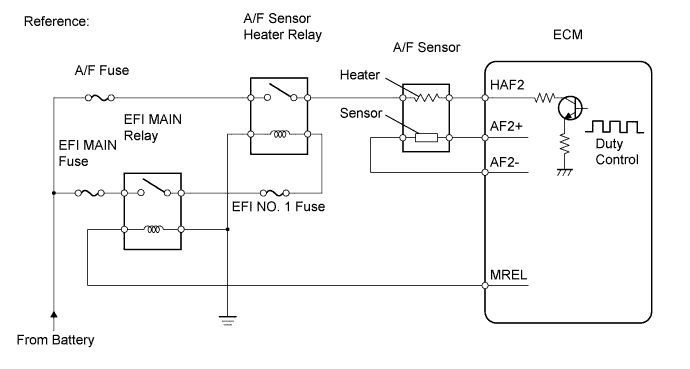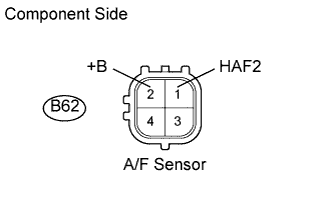DTC P2237 Oxygen (A/F) Sensor Pumping Current Circuit / Open (Bank 1 Sensor 1)
DTC P2238 Oxygen (A/F) Sensor Pumping Current Circuit Low (Bank 1 Sensor 1)
DTC P2239 Oxygen (A/F) Sensor Pumping Current Circuit High (Bank 1 Sensor 1)
DTC P2252 Oxygen (A/F) Sensor Reference Ground Circuit Low (Bank 1 Sensor 1)
DTC P2253 Oxygen (A/F) Sensor Reference Ground Circuit High (Bank 1 Sensor 1)
Description
HINT:
- For more information on the A/F sensor and TOYOTA D-CAT*, refer to the following procedures.
- These DTCs are related to the A/F sensor, although the titles say oxygen sensor.
- If P2237, P2238 and/or P2239 is present, refer to the DTC table for TOYOTA D-CAT system.
- These DTCs are recorded when A/F sensor has malfunction, although the titles say oxygen sensor.
*: Diesel Clean Advanced Technology.
The A/F sensor has the characteristic of providing output voltage which is proportional to the existing air- fuel ratio. The A/F sensor output voltage*1 is used to provide the ECM with feedback to control the air-fuel ratio.
The A/F sensor is located after the DPNR*2 catalytic converter. This sensor has been developed based on the structure and technology of the sensor used for gasoline engines. The cover portion of the sensor has been changed for use in the diesel engine with TOYOTA D-CAT in order to eliminate the influence of the sensor temperature and particulate matter (PM).
In order to reduce both PM and nitrogen oxides (NOx), the ECM adjusts the air-fuel ratio to slightly RICH (LEAN compared with a stoichiometric air-fuel ratio) based on signals from the A/F sensor. When the ECM exercises DPNR catalyst regeneration by adding fuel using the exhaust fuel addition injector, the air-fuel ratio is also properly adjusted through the sensor.
*1: The voltage value changes inside the ECM only.
*2: Diesel Particulate-NOx Reduction system.

HINT:
The ECM provides a pulse width modulated control circuit to adjust current through the heater. The A/F sensor heater circuit uses a relay on the B+ side of the circuit.

Toyota fault code list 2AD-FHV DTC P2237, DTC P22378, DTC P2239, DTC P2252, DTC P2253
| DTC No. | DTC Detection Condition | Trouble Area |
| P2237 | ECM internal error (5.0 seconds) (1 trip detection logic) |
ECM |
| P2238 P2252 |
A/F sensor circuit low (bank 1 sensor 1) AF+ is less than 1.0 V for 5.0 seconds or more (1 trip detection logic) |
Main trouble area: Open in A/F sensor circuit
|
| P2239 P2253 |
A/F sensor circuit high (bank 1 sensor 1) AF+ is more than 4.0 V for 5.0 seconds or more (1 trip detection logic) |
Main trouble area: Short in A/F sensor circuit
|
Monitor description
The A/F sensor varies its voltage output in proportion to the air-fuel ratio. If impedance (alternating current resistance) or voltage output of the sensor deviates greatly from the standard range, the ECM interprets this as an open or short malfunction of the A/F sensor circuit.
Wiring diagram
Inspection procedure
NOTICE:
After replacing the ECM, the new ECM needs registration and initialization.
| 1.CHECK OTHER DTC OUTPUT (IN ADDITION TO DTC P2237) |
-
Connect the intelligent tester to the DLC3.
-
Turn the ignition switch on (IG) and turn the tester ON.
-
Enter the following menus: Powertrain / Engine and ECT / DTC.
-
Read DTCs.
Result:Display (DTC Output) Proceed to P2237 and P2238, P2239, P2252 and/or P2253 A P2237 B
|
|
||||
| A | |
| 2.INSPECT AIR FUEL RATIO SENSOR (HEATER RESISTANCE) |

-
Disconnect the B62 A/F sensor connector.
-
Measure the resistance of the terminals of the A/F sensor.
Standard resistance:
Tester Connection Condition Specified Condition B62-1 (HAF2) - B62-2 (+B) 20°C (68°F) 1.8 to 3.4 ? -
Reconnect the A/F sensor connector.
|
|
||||
| OK | |
| 3.INSPECT INTEGRATION RELAY (A/F RELAY) |

-
Remove the integration relay from the engine room No. 1 relay block.
-
Inspect the A/F fuse.
-
Remove the A/F fuse from the integration relay.
-
Measure the resistance of the fuse.
Standard resistance:
Below 1 ?
-
Reinstall the A/F fuse.
-
-
Inspect the A/F relay.
-
Measure the A/F relay resistance.
Standard resistance:
Tester Connection Specified Condition 1B-8 - 1C-1 10 k? or higher 1B-8 - 1C-1 Below 1 ? (Apply battery voltage to terminals 1B-6 and 1B-7) -
Reinstall the integration relay.
-
|
|
||||
| OK | |
| 4.CHECK WIRE HARNESS (A/F SENSOR - ECM) |

-
Disconnect the B62 A/F sensor connector.
-
Disconnect the B32 ECM connector.
-
Measure the resistance of the wire harness side connector.
Standard resistance:
Tester Connection Specified Condition B62-1 (HAF2) - B32-104 (HAF2) Below 1 ? B62-1 (HAF2) or B32-104 (HAF2) - Body ground 10 k? or higher -
Reconnect the A/F sensor connector.
-
Reconnect the ECM connector.
|
|
||||
| OK | |
|